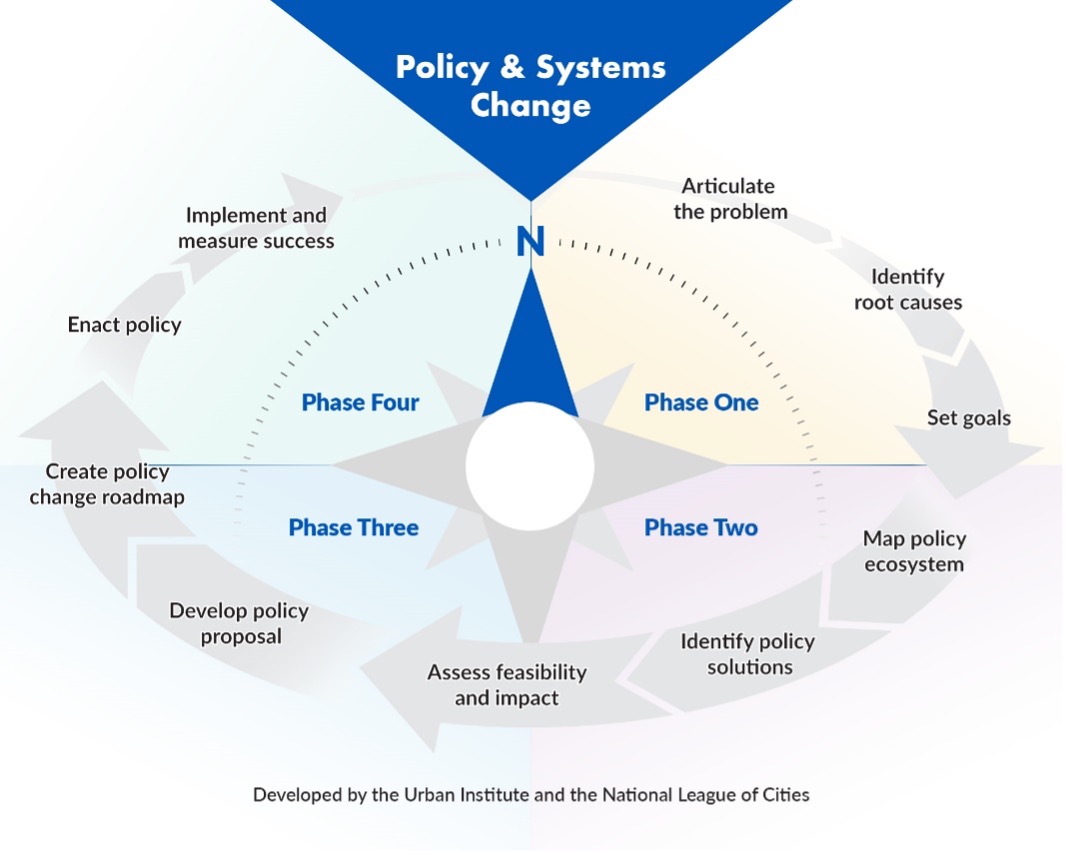
This post was originally published on CitiesSpeak, the blog of the National League of Cities. We have made some edits to adhere to Urban editorial style.
Every day, cities across the country confront complex, interconnected issues—spanning health, housing, workforce development, and climate change. Municipal leaders have the power to bring about transformative progress toward health and equity in their communities but often don’t have the opportunity or resources to explore the root causes or gather evidence that could support the policy and systems changes needed to advance equity in their communities.
To respond to these challenges, the National League of Cities’ (NLC’s) Cities of Opportunity (CoO) program partnered with the Urban Institute to develop a new Policy and Systems Change Compass process (“Compass”). CoO and Urban then partnered with three cities—Dubuque, Iowa; Roanoke, Virginia; and Tacoma, Washington—to pilot the Compass.
The final Compass process takes municipal teams on a journey across 10 steps that supports identifying and implementing strategic, evidence-based policy solutions to complex problems.

So how can cities apply some of the Compass best practices to their policy work? Here are a few key steps from the Compass:
Identify root causes
A foundational step of the Compass is taking the time to uncover the roots of community challenges. The challenges many cities experience—low workforce participation, lack of affordable housing, high levels of crime—are often the symptoms of the problems we need to address and not the main problems themselves. For example, low workforce participation can be a symptom of a lack of affordable child care options, a lack of transportation options, or a failure of companies to recruit among certain populations. This focus on root causes, rather than symptoms, ensures city leaders identify more strategic and impactful solutions.
Set population goals and desired systems changes
When setting the vision for success, it’s important to not only set goals for what changes we want to see among the target population but also to explicitly state the systems changes needed to achieve that goal. The Compass guides teams in setting systems goals that define how policies, programs, processes, and practices will change to achieve the stated impacts.
For example, setting a goal to “increase workforce participation by 10 percent” is important, but alone may lead governments to narrow, less impactful, individually focused solutions. Instead, setting a systems goal to “better connect workforce development programs to the supportive services people need to take advantage of these programs” directly addresses systemic challenges and will result in broad, population-level benefits.
Map the policy ecosystem
To find the best policy for a city’s unique contexts and challenges, the Compass guides teams to map the policy ecosystem around a prioritized root cause. This includes first identifying a full range of policy actions. For example, when looking at a root cause of “lack of quality and accessible child care options” this might include wage policies that influence how well child care workers are paid, zoning policies that control the location and size of child care facilities, and child care licensing policies that influence the number of registered facilities and child care providers. Once a full range of potential policies has been identified, the next step is to consider these policies against the city’s current policies, as well as the forces, organizations, people, and contexts that may influence the policy choices.
Assess the feasibility and potential of policy options
To choose the right policy change, the Compass emphasizes the importance of local leaders considering which policy options are both feasible and maximize the desired systems and population impacts. Feasibility considerations include departmental and staff capacity to implement the policy, political dynamics, budget alignment, partner organization capacity to implement, public support, and a clear window of opportunity to implement the policy. Considerations around potential impact include whether the policy will reach the intended systems or populations, whether the policy will reduce disparities, how much the policy can scale change, and whether the policy will lead to more equitable changes over time.
Next steps
Following the conclusion of the Compass pilot, Urban and NLC worked together to update the Compass based on the experiences of the pilot cities, and we are continuing to explore ways to provide additional technical assistance and support to other cities that may want to use the Compass process to achieve policy and systems change in their jurisdiction.
To learn more about the full Policy and Systems Change Compass process, please read the full brief here, or contact the Cities of Opportunity team at [email protected].
Let’s build a future where everyone, everywhere has the opportunity and power to thrive
Urban is more determined than ever to partner with changemakers to unlock opportunities that give people across the country a fair shot at reaching their fullest potential. Invest in Urban to power this type of work.